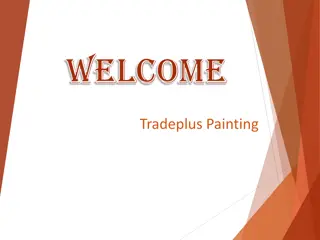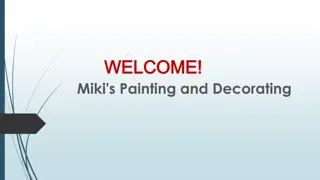Unveiling the World of Painting: Types, Styles, and Techniques
Delve into the diverse realm of painting, from its 2D essence to major genres like landscapes, portraits, still life, real life scenes, and religious art. Explore the various styles artists employ to convey realism or emotions. Discover mural painting techniques that seamlessly blend art with architecture, creating stunning works on walls and ceilings. Unravel the beauty and versatility of painting in capturing moments, emotions, and stories on different surfaces.
Download Presentation

Please find below an Image/Link to download the presentation.
The content on the website is provided AS IS for your information and personal use only. It may not be sold, licensed, or shared on other websites without obtaining consent from the author.If you encounter any issues during the download, it is possible that the publisher has removed the file from their server.
You are allowed to download the files provided on this website for personal or commercial use, subject to the condition that they are used lawfully. All files are the property of their respective owners.
The content on the website is provided AS IS for your information and personal use only. It may not be sold, licensed, or shared on other websites without obtaining consent from the author.
E N D
Presentation Transcript
Painting Painting is a 2 D Art as it is created on the 2D surfaces. Like walls, ceilings, paper, leather , skin and on canvases. The surfaces could vary its type but it will sustain it s 2 D element. Painting could be done on sculptural art as well to enhance its artistic properties. Painting creates ILLUSION OF 3D on the 2 D surfaces.
MAJOR TYPES (genre) OF PAINTING A landscape is an outdoor scene. A landscape artist uses paint to create not only land, water, and clouds but air, wind, and sunlight. A portrait is an image of a person or animal. Besides showing what someone looks like, a portrait often captures a mood or personality. A still life shows objects, such as flowers, food, or musical instruments. A still life reveals an artist's skill in painting shapes, light, and shadow. A real life scene captures life in action. It could show a busy street, a beach party, a dinner gathering, or anyplace where living goes on. A religious work of art shares a religious message. It might portray a sacred story or express an artist's faith
Style Some paintings seem to show exactly what an artist saw, while others focus on exploring shapes or expressing feelings. One artist might paint a landscape with realistic details, such as craggy rocks and green blades of grass. Another might paint the same landscape in swirling shapes and colors that capture how the air and sunlight felt.
Techniques of painting Mural painting Easel painting Miniature painting
Mural painting A mural is any piece of artwork painted or applied directly on a wall, ceiling or other large permanent surface. A distinguishing characteristic of mural painting is that the architectural elements of the given space are harmoniously incorporated into the picture. Some wall paintings are painted on large canvases, which are then attached to the wall (e.g., with marouflage). Whether these works can be accurately called "murals" is a subject of some controversy in the art world, but the technique has been in common use since the late 19th century.[1]
A Mural painting could be Painted Mosaic Fiber glass Glass Photograph Ceramic/clay etc A Mural is an art work which is directly done on wall or made for the wall
Easel painting Easel painting is a term in art history for the type of mid-size painting that would have been painted on an easel, as opposed to a fresco wall-painting or miniature that would have been created sitting at a desk, though perhaps also on an angled support. It does not refer to the method of display after creation; in fact most easel paintings are intended to be displayed framed and hanging on a wall
History of easel painting Easels are known to have been in use since the time of the ancient Egyptians. In the 1st century, Pliny the Elder makes reference to a large panel placed upon an easel.
Miniature (illuminated manuscript) The word miniature, derived from the Latin minium, red lead, is a picture in an ancient or medieval illuminated manuscript; the simple decoration of the early codices having been mini-ated or delineated with that pigment. The generally small scale of the medieval pictures has led secondly to an etymological confusion of the term with minuteness and to its application to small paintings especially portrait miniatures, which did however grow from the same tradition and at least initially use similar techniques.
Apart from the Western and Byzantine traditions, there is another group of Asian traditions, which is generally more illustrative in nature, and from origins in manuscript book decoration also developed into single-sheet small paintings to be kept in albums, which are also called miniatures, as the Western equivalents in watercolor and other mediums are not. These include Persian miniatures, and their Mughal, Ottoman and other Indian offshoots.
Persia (Iran) Safavid era Miniature painting kept at Shah Abbas Hotel in Isfahan. Yusuf and Zulaikha (Joseph chased by Potiphar's wife), miniature by Behz d, 1488. Main article: Persian miniature Persian art has a long tradition of the use of miniatures. Reza Abbasi (1565 1635), considered one of the most renowned Persian painters of all time, specialized in the Persian miniature, with a preference for naturalistic subjects. Today his surviving works can be found in many of the major museums of the Western world, such as the Smithsonian, the Louvre and the Metropolitan Museum of Art.
Mughal miniatures Main article: Mughal painting The Emperor Jahangir receiving his two sons, an album-painting of c 1605-06 Mughal painting, generally confined to miniatures either as book illustrations or as single works to be kept in albums, emerged from the Persian miniature painting tradition, with Indian influences, and developed during the period of the Mughal Empire (16th -19th centuries). Mughal miniatures are very detailed and very fine in quality. Padshanama is important book of the Mughal miniature Painting
Ottoman empire Portrait of a painter during the reign of Mehmet II Main article: Ottoman miniature
Forgeries Medieval miniatures have been forged to deceive collectors by various persons most notably including the Spanish Forger.
Sub-Techniques of mural painting Fresco (boun) Fresco (secco) Mosaics Stained glass Tempera Mix media
Fresco (buon) Buon fresco (Italian for true fresco) is a fresco painting technique in which alkaline resistant pigments, ground in water, are applied to plaster when it is still wet, as opposed to fresco-secco (or a secco). The buon fresco technique consists of painting with pigment ground in water on a thin layer of wet, fresh, lime mortar or plaster, for which the Italian word for plaster, intonaco, is used. Because of the chemical makeup of the plaster, a binder is not required. After a number of hours the plaster reacts with the air in a process called carbonatation: this chemical reaction fixes the pigment particles at the plaster's surface in a protective crystalline mesh[1]known as the lime crust. One of the first painters in the post-classical period to use this technique was the Isaac Master in the Upper Basilica of Saint Francis in Assisi























